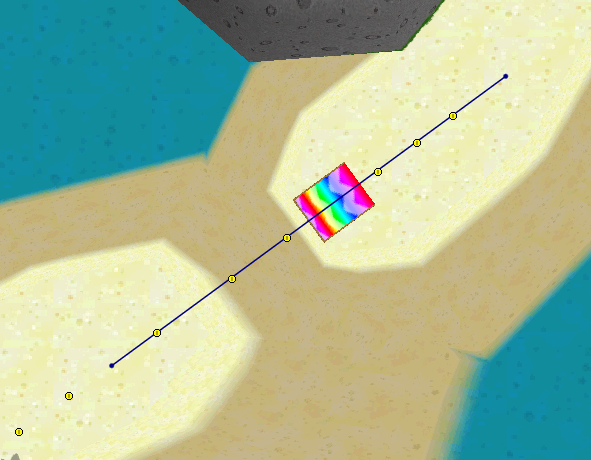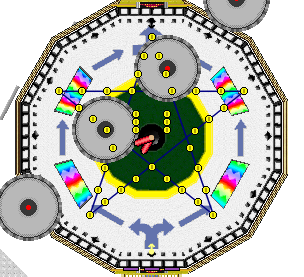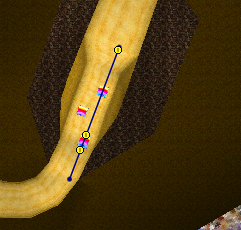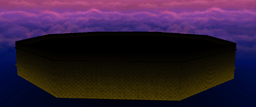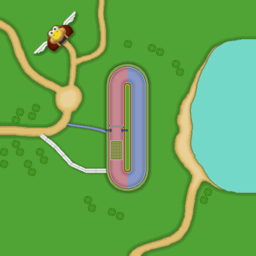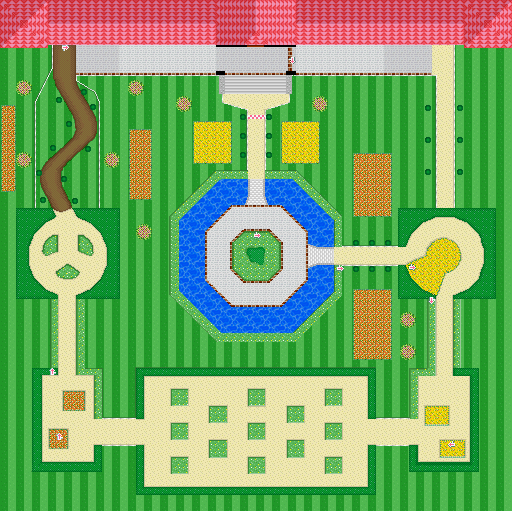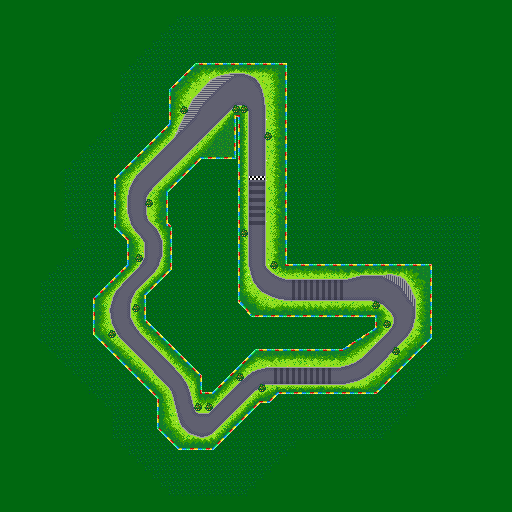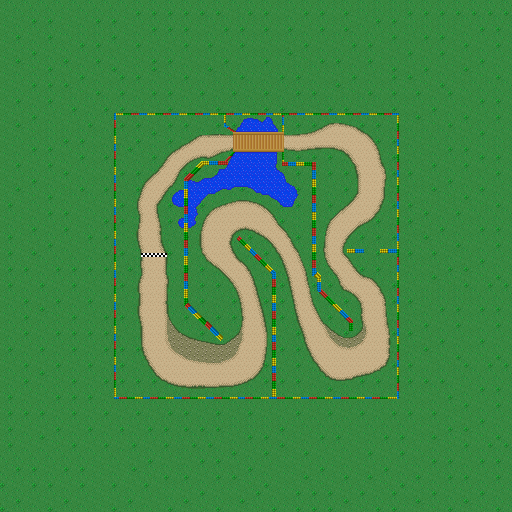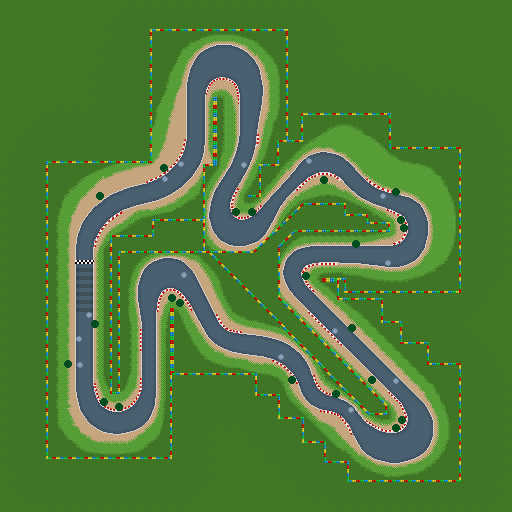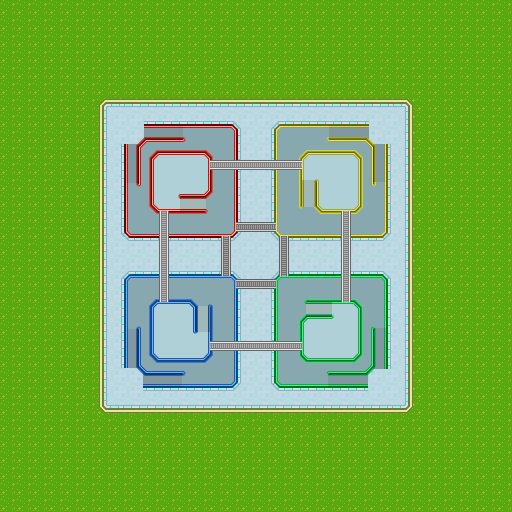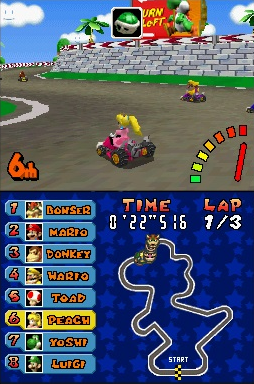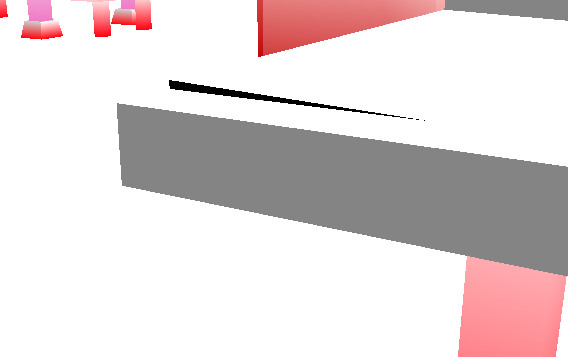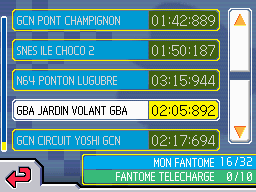Mario Kart DS/Oddities
This is a sub-page of Mario Kart DS.
Contents
- 1 Early and Leftover Content in Missions
- 1.1 Yoshi Falls
- 1.2 Cheep-Cheep Beach
- 1.3 Delfino Square
- 1.4 Tick-Tock Clock
- 1.5 Airship Fortress
- 1.6 Wario Stadium
- 1.7 Peach Gardens
- 1.8 Bowser Castle
- 1.9 N64 Moo Moo Farm
- 1.10 N64 Frappe Snowland
- 1.11 GBA Bowser Castle 2
- 1.12 Twilight House
- 1.13 Palm Shore
- 1.14 Tart Top
- 1.15 mini_block_course (GCN Block City)
- 2 Odd Hidden Skyboxes
- 3 Hidden Bottom Map Graphic
- 4 Startup Sound Oversight
- 5 Road Collision Sound Oddity
- 6 Early Content in Course Previews
- 7 Early Content in Overview Maps
- 8 Trophy Screen Place Marker Graphic Oddity
- 9 Texture Oddities
- 10 Model Oddities
- 11 Retro Console Prefix Oddity
- 12 Early Track Leftovers
- 13 Early Music Leftovers
- 14 Unused Sound Effect Sequences
- 15 Sound Effect Oddities
Early and Leftover Content in Missions
Some missions, especially the first ones created (judging by their IDs) have leftovers from different points of the game's development.
Yoshi Falls
| Early | Final |
|---|---|
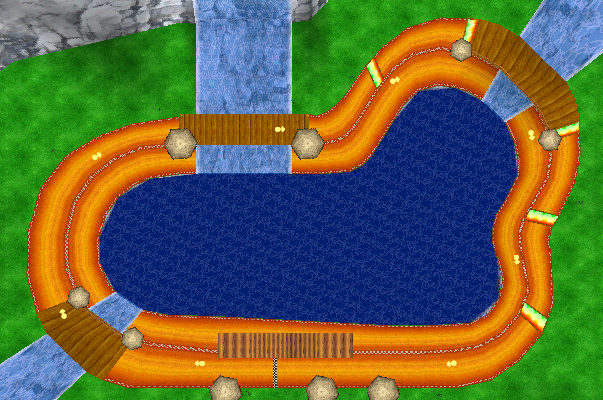 |
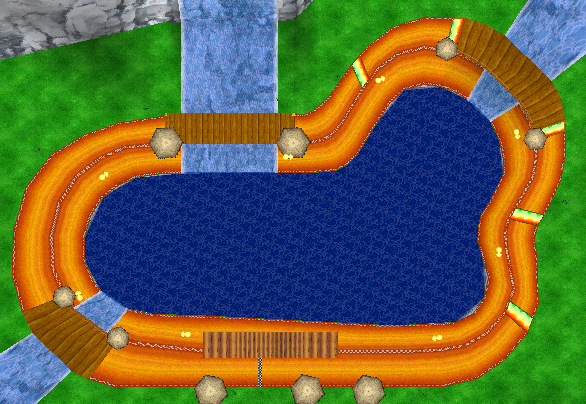 |
Mission 1-3 (mr12) retains the respawn formation from the Kiosk Demo version of the track; however, mission 3-4 (mr85) doesn't.
Cheep-Cheep Beach
Mission 2-5 contains a leftover path used to align coins.
Delfino Square
| Early | Final |
|---|---|
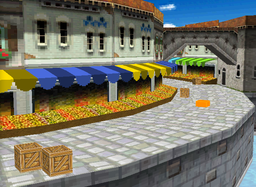 |
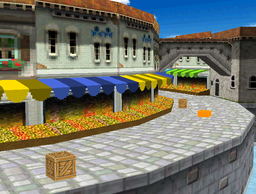 |
| Early | Final |
|---|---|
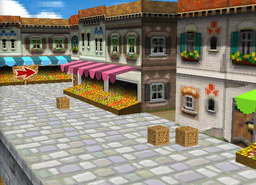 |
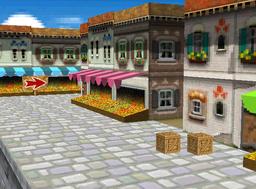 |
| Early | Final |
|---|---|
 |
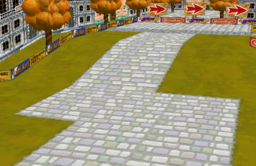 |
If you go out of bounds in mission 3-2 (mr47), where you have to drive though gates in reverse on Delfino Square, you will see that there are crates in different positions with additional crates, different than they are in regular racing. This is a remnant from the Kiosk Demo version. The two removed crates before the turn to the goal line can also be seen in mission 2-1 (mr26).
Tick-Tock Clock
Mission 6-7 contains a path with five points that form a star shape, used to align the coins into a star formation yet left in said mission's NKM file.
Airship Fortress
| Early | Final |
|---|---|

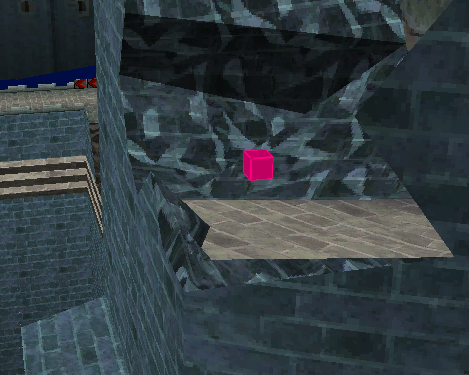 |
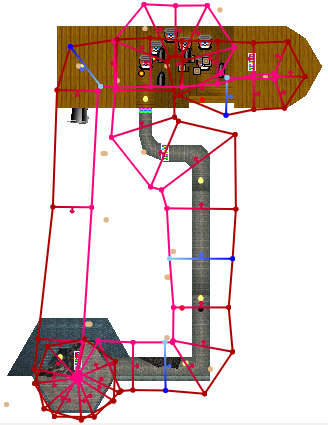
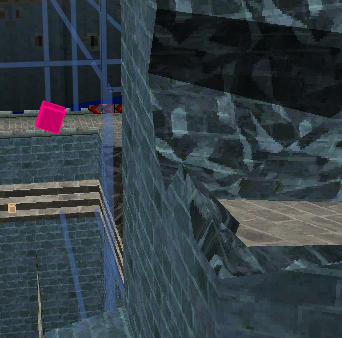 |
Mission 6-2 (mr08) features CPOI (checkpoints) with three keypoints instead of four (shown here as blue lines). The order is also wrong; CPOI 0 should be on the starting line as it's responsible for lap counts, but CPOI 33 is there instead. CPOI 0 is right after the first boost pad; if those checkpoints were to be imported to the main track, the lap will count before entering the Rocky Wrenches' area. The respawn ID for all points is also set to 0, which suggests that there was only one respawn point at first (the main track uses six).
The KTPC (end of cannon point, shown here as pink box) is also located a bit further than where it is in the final, meaning the player would stop flying right after the cracked wall, rather than slightly before it.
Oddly, the main track in Kiosk Demo uses the final CPOI and KTPC, and Mission 8 (final 6-2) uses the early ones; these are possibly leftovers from an earlier version before the Kiosk Demo.
None of this is the case in Mission 7-7 (mr69).
Wario Stadium
Mission 7-5 contains a path used to align coins.
Peach Gardens
| Early | Final |
|---|---|
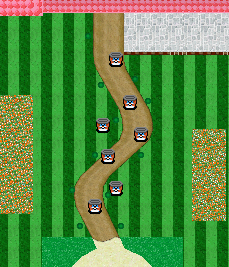 |
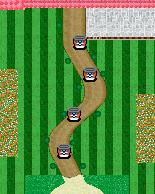 |
| Early | Final |
|---|---|
 |
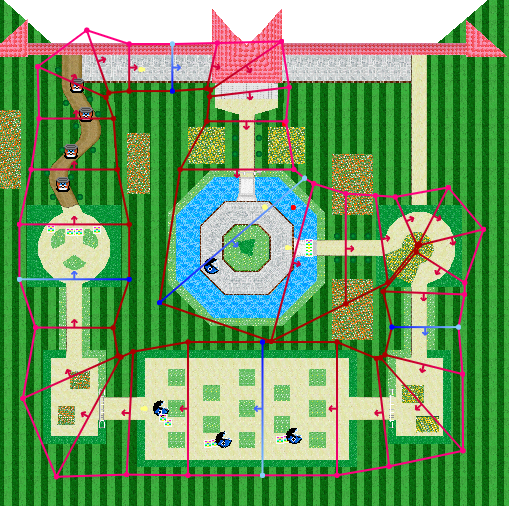 |
Mission 5-1 (mr04) still retains the removed Monty Moles from the Kiosk Demo version of the track, but Mission 6-8 (mr90) doesn't, as it's one of the last missions made, likely around the finalization stage.
Mission 5-1 also contains different CPOI (checkpoints) and respawns compared to the main course; checkpoints have 30 points instead of 33, and the respawns are set and placed differently. This is also the case in the Kiosk Demo: the main track uses final main track's CPOI and respawns, and Mission 4 (final 5-1) uses the early ones. It's possible that this early CPOI and respawns might belong to an earlier version of the course, likely before the Kiosk Demo.
Another 5-1 oddity is that the Chain Chomp on the circular area at the beginning is missing, which is a leftover from the Kiosk Demo mission, as it lacked all the Chain Chomps (except the one that the player races against). This implies that an earlier version of the track didn't have Chain Chomps at all (or they might be removed for the mission), and the devs forgot to add that one chomp in the final mission. This is not the case in 6-8, however.
Mission 6-8 uses final checkpoints and another different respawn configuration.
Bowser Castle
| Mission 6-1 | Mission 7-2 | Kiosk Demo | Final |
|---|---|---|---|

|
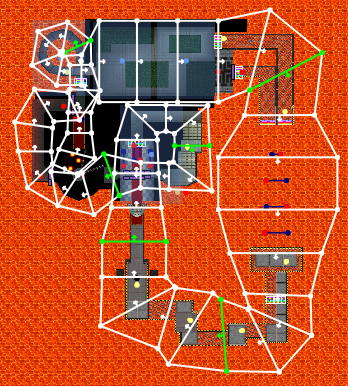
|
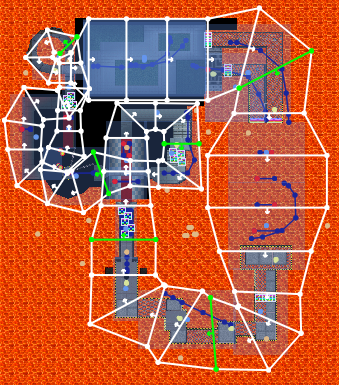
|
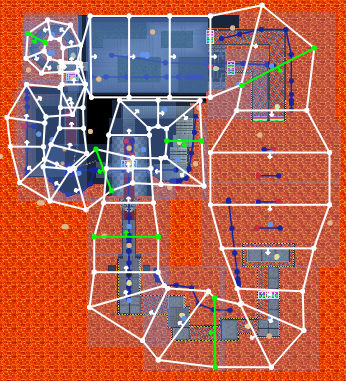
|
Mission 6-1 (mr64) contains CPOI (checkpoints) with 44 points, as opposed to 51 in the main track and 48 in Kiosk Demo. The formation seems to be that from Kiosk Demo except for some differences in the helix road (top-left, before the bridge) and the lack of the shortcut section. Judging by the fact that the CPOI IDs for the shortcut are 44 onwards (47 in the main track), this CPOI section was probably added later.
KTP2 (unused?)'s Z-position is 1650 as in Kiosk Demo, as opposed to 1760 in the main track.
Some of the KTPJ (respawn) point locations are also different than both Kiosk Demo's and the final's. IPOI IDs are also from Kiosk Demo, but the KTPJs 1, 3, and 5 have different IDs (90-35-76 as opposed to 91-36-86). EPOI IDs are from final except for KTPJ 7's (80 instead of 79).
Mission 7-2 (mr89) has the same CPOI as Kiosk Demo except for one more point in the helix road, making up 49 points. KTPJ and KTP2 locations are the same as that of Mission 6-1 (mr64)'s.
It's possible the CPOI in Mission 6-1 (mr64) is from before Kiosk Demo and the one in Mission 7-2 (mr89) is from a later build. KTPJ might be a later one, however.
What's even more odd is that none of the two missions exist in Kiosk Demo (or a mission on this track, at least).
N64 Moo Moo Farm
| Early | Final |
|---|---|
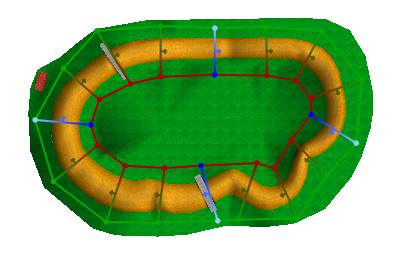 |
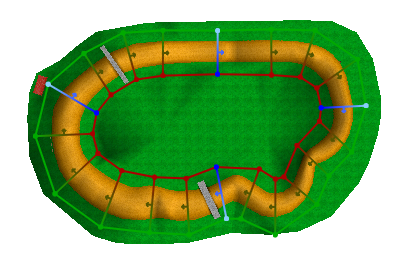 |
While the CPOI (checkpoints as shown in the images) formation is the same in both main course NKM and the missions, this is not the case with Mission 1-7 (mr06). It seems to use an earlier CPOI with 16 points, rather than 20. Mission 3-6 (mr02), however, uses the same CPOI formation as the main course NKM.
Oddly, the Kiosk Demo version of this track has the same CPOI as the final (20 points); however, both missions (2 and 6) use the early CPOI with 16 points.
Possibly this CPOI formation might have been used in an earlier version of the course; in a build before the Kiosk Demo, in this case.
N64 Frappe Snowland
Mission 5-2 contains a leftover path used to align coins.
GBA Bowser Castle 2
| Early | Final |
|---|---|
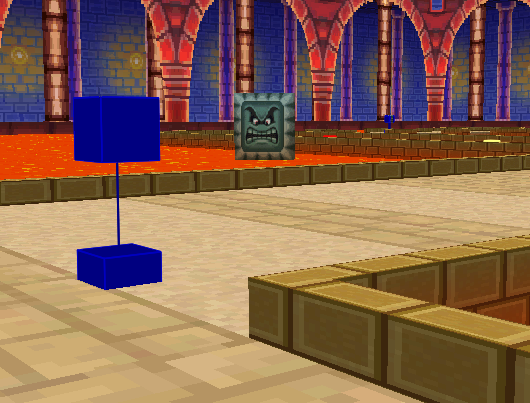 |
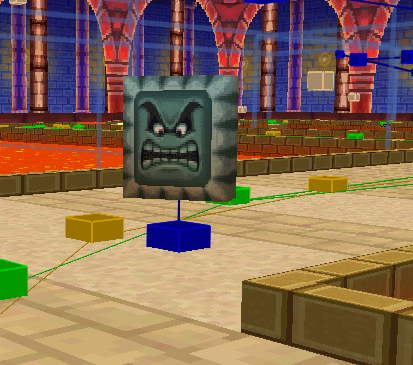 |
Mission 5-4 (mr37) still features the smaller thwomps from the Kiosk Demo version of the track. However, the track is in y=100 base in Kiosk Demo, and in y=600 base in final, possibly indicating that the thwomps were upscaled after the model was moved higher up.
Twilight House
While the course's main NKM has the Shine Runners time limit set to 60 seconds, the NKM used by mission 3-8 (mr80) has it set to 120 seconds. The KCL collision colors also aren't set in the mission NKM.
Palm Shore
While the course's main NKM has the Shine Runners time limit set to 60 seconds and the NKM background color 0:0:248 (blue), the NKM used by mission 4-2 (mr39) re-uses the settings from mini_block_course; Shine Runners time limit is set to 180 seconds and the NKM background color is 248:248:248 (white), as with all other battle courses in the Kiosk Demo. This suggests that the mission was made before the default Shine Runners time limit was changed (and NKM BG color changed in overall).
Tart Top
While the course's main NKM has the Shine Runners time limit set to 60 seconds, the NKM used by mission 5-6 (mr78) has it set to 120 seconds.
mini_block_course (GCN Block City)
| Early | Final |
|---|---|
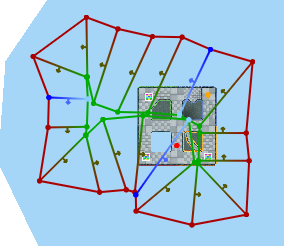 |
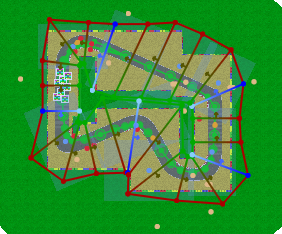 |
Found in the unused Big Bully boss NKM in mini_block_course (mr10_tool.nkm) is an earlier CPOI (checkpoint) formation for SNES Mario Circuit 1, with 19 points instead of 23. It also appears in the NKM for missions 5, 9 and 10 (the lattermost is where the NKM is used) in Kiosk Demo.
The order is also entirely wrong in every NKM it appears: CPOI 0, where the lap will count, should be on the starting line, but it's on the third left turn instead. The one in the starting line is CPOI 8. If this CPOI formation is imported directly into SNES Mario Circuit 1, the lap will count on the third turn due to this incorrect order.
However, SNES Mario Circuit 1 in Kiosk Demo uses the final's CPOI formation, so it's possible this early formation might be used in an earlier version of the course; in a build before Kiosk Demo, in this case.
Odd Hidden Skyboxes
For whatever reason, the courses used for the boss battles in mission mode (mr_stage1, mr_stage2 and mr_stage3) have hidden skybox models that can only be seen in an editor or by using cheat codes to fly out of bounds. They are copied from Desert Hills (mr_stage1 and 3) and Airship Fortress (mr_stage2), and don't fit the look of these courses at all.
This might suggest the arenas originally had sky backgrounds, a la Super Mario 64 DS.
MR_stage1 in the Kiosk Demo also doesn't have a background nor a skybox, which might further suggest that.
Hidden Bottom Map Graphic
| To do: Is there more? Like in Peach Gardens with an unseen path. |
The Paratroopa-shaped building in Baby Park cannot normally be seen on the touch screen map because it is too far out-of-bounds. By using cheats to fly out of bounds, however, it can be seen.
Startup Sound Oversight
| To do: Document differences in behaviour between the DS models and firmwares (e.g., the voice clip on the original DS is usually "Yahoo!", but on a DS Lite, DSi, 3DS and even some phat DSes it's "Here we go!"). |
When the game is starting up, on the Nintendo copyrights splash screen (which has the ESRB Notice in the American version), a jingle consisting of a sample of a passing car and a Mario phrase is played. At this point, the game twice chooses a random number between 0 and 100 inclusive. The first value selects which car sample will be played, and the second which Mario phrase:
- If the first value is between 0 and 20, a long "vroom" sample will be heard; otherwise, it's a double "vroom".
- If the second value is between 0 and 20, Mario will shout "Yahoo!"; if not, he'll say "Here we go!".
| Value | Car sample | Mario's sample |
|---|---|---|
| 0-20 | ||
| 21-100 |
However, the values chosen are not exactly random, given that the double "vroom" is selected almost all the time, while Mario tends to say "Yahoo!" on Nintendo DS Phat models and "Here We Go!" on all other platforms. These values are chosen by a Linear Congruential Generator RNG whose static seed is 0x12345678. What's more, the RNG continues to advance even when it's not needed, including during the game's loading time. Because of this, the sequence of random numbers generated will always be the same leading to the same results every time, controlling for all other factors (model of DS, use of Action Replay, etc). Another example of sounds being different on the Nintendo copyrights start-up screen is Nintendogs, where the dog bark sounds vary every time the game starts up.
While the load times for the games can be modified by the milliseconds by something like an Action Replay or using a different DS model (as there are slight differences in the game's load time between models), and this can cause a different sequence of sound effects to play, if those same actions are repeated it will lead to the same sounds playing each time. So, even though the values chosen were supposed to be random, they are instead based on the console's loading time due to a possible oversight.
Interestingly, switching the console to sleep mode or bringing up the HOME menu prompt during the intro screen on 3DS resets the RNG values, allowing all possible sample combinations for the intro jingle to be heard on the same console. In addition, if the long "vroom" is played, Mario's selected sample will be played slightly earlier than if it were the double "vroom".
| Values | Jingle | |
|---|---|---|
| Value 1 | Value 2 | |
| 0-20 | 0-20 | |
| 0-20 | 21-100 | |
| 21-100 | 0-20 | |
| 21-100 | 21-100 | |
Road Collision Sound Oddity
The collision ID used for the roads in Waluigi Pinball and Mushroom Bridge is the same as the one used in the Kiosk Demo, despite the fact that it produces a metallic sound in the demo and the normal road sound in the final. This is because rather than changing the collision ID in the KCL (collision model), the metal road sound sequence data was overwritten with the normal road sound sequence data.
In the SSAR sequence data, in SSAR 0 and 1, sequence numbers 84 and 143 belong to the normal asphalt road, and 98 and 154 are the same but belong to the metal road (Waluigi Pinball).
Early Content in Course Previews
| To do: List the other differences. |
| This page or section needs more images. There's a whole lotta words here, but not enough pictures. Please fix this. |
Some course previews contain stuff that was changed in the final game.
SNES Mario Circuit 1
This preview is the same as that of the Kiosk Demo version where the road was gradiented and the multi-color blocks were darker. The textures were changed in the final track.
N64 Frappe Snowland
- Mario's statue is shaded differently. A similarly-shaded statue (probably this one) appears in the Kiosk Demo's touch screen map for this track.
- Vertex colors on the arrow sign and out-of-bounds areas are missing.
- The sky background is duller in color.
- The snowman in front of the statue doesn't appear in the track.
Oddly, the Kiosk Demo track uses the final model, possibly because this picture was made before the Kiosk Demo era but never implemented.
GCN Baby Park
- Vertex colors in the side barriers are missing, having them in white instead of yellow.
- The shadow under the track is positioned differently.
- The MARIOKART banner on the start line is larger.
Like N64 Frappe Snowland mentioned above, the Kiosk Demo track uses the final model; possibly, this picture was made before the Kiosk Demo but never implemented.
GCN Mushroom Bridge
The Cheep-Cheep trucks use their Kiosk Demo model with FLESH instead of FRESH.
Early Content in Overview Maps
Peach Gardens' local map still has the darker mud towards the end, from the Kiosk Demo version of the course. The extra trees from said version are removed, however.
The order of block colors in GBA Peach Circuit's map is different compared to the track model. This is not the case with SNES Mario Circuit 1 from the same cup. The out-of-bounds areas are also depicted using a darker grass texture.
The order of block colors in SNES Donut Plains 1's map is different compared to the track model. The water also appears to use a different texture.
The order of block colors in GBA Luigi Circuit's map is different compared to the track model. This is not the case with SNES Koopa Beach 2 from the same cup, nor SNES Choco Island 2 from Lightning Cup.
There're also six dark lines on the road before the starting line, instead of seven.
Block Fort's map still has the gray bridge textures from the Kiosk Demo version of the stage. The final version uses a more white texture.
Trophy Screen Place Marker Graphic Oddity
In the USA and EU (multiplayer) Kiosk Demo versions of the game, the place markers in the trophy screen have labels under them:
- 1st = FIRST
- 2nd = SECOND
- 3rd = THIRD
- 4th = FOURTH
- 5th = FIFTH
- 6th = SIXTH
- 7th = SEVENTH
- 8th = EIGHTH
The labels actually still exist in the final version, but their graphics are blanked out. Their OAM data, as well the tiles reserved for them, are intact.
The same blank graphics also exist in the localized variants, suggesting that the graphics were also localized at one point. However, some of the localized text wouldn't have fit onto the 64x8 blocks reserved for them, which might've been the reason for the labels being scrapped.
This suggests that the labels were removed late in development.
Texture Oddities
| To do: There's more. |
Skyboxes
Unused courses luigi_course, nokonoko_course and old_mario_gc have their sky texture palette internally named "olg_real_sky". olg_ suggests that either this texture was made for GCN Luigi Circuit first, or the palette might've been re-used there, as olg is the short internal name for GCN Luigi Circuit (it stands for old_luigi_gc). The palette is also different in both tracks.
luigi_course's skybox texture is also internally named "ng_real_sky", which suggests that this model or the texture was used in Peach Gardens at some point, since ng is the short internal name of the said course (standing for nitro garden).
N64 Starting Banner
| Early | Final |
|---|---|
 |
The texture for the MARIOKART flag at the beginning in N64 Choco Mountain is internally named mo_logo01 (mo_ being the short internal name for N64 Moo Moo Farm), implying that this texture was also used in N64 Moo Moo Farm at some point. The texture used in N64 Moo Moo Farm is internally named mo_logo02 (also used in N64 Frappe Snowland), which supports this being the case.
The early texture appears to more closely resemble its appearance from Mario Kart 64, albeit in lower resolution. The final texture is in the original resolution, but has been edited to have a waving effect, and the poles were darkened.
Unused Tracks' Starting Banners
| old_mario_gc | nokonoko_course |
|---|---|
While the textures are the same, the banner texture in old_mario_gc is uncompressed (direct color), and its poles' texture is in 256-color format. In nokonoko_course, however, both textures are 4x4 compressed, resulting in quality degrade.
donkey_course in Kiosk Demo also uses the same compressed textures as nokonoko_course, and judging by the courses' IDs (02, 06 and 08 being, in order, old_mario_gc, donkey_course, and nokonoko_course), indicating that old_mario_gc was made before the other two, it's possible the textures in old_mario_gc might be earlier ones.
Peach Gardens Starting Banner
Its palette is internally named m_ma_su01_pl, which is also used in nokonoko_course. This might suggest that the track originally had the starting banner from said track.
DK Pass Starting Banner
| Early | Final |
|---|---|
Its palette is internally named m_ma_su01_pl, which is also used in Kiosk Demo's donkey_course, a draft design of the course that had a different starting banner. This is possibly a leftover from said track.
GCN Yoshi Circuit Road
| old_mario_gc | GCN Yoshi Circuit |
|---|---|
While the texture is the same, the texture used in old_mario_gc is 256 colors whereas the one in GCN Yoshi Circuit is 4x4 compressed, hence why the textures are dithered differently. old_mario_gc's texture appears used in GCN Yoshi Circuit in E3 2004 and in SNES Mario Circuit 1 in a later prototype.
Starting Lines
N64 Choco Mountain
| Early | Final |
|---|---|
N64 Choco Mountain uses a start line texture with the name of6_ki1 (where of6 stands for old_frappe_64), implying it's an earlier texture for the one in N64 Frappe Snowland, which is internally fra_kuro3. The difference in the early texture is brighter colors and the lack of dithering.
The early texture can also be seen in Kiosk Demo's touch screen map, yet the track model in the said version uses the final texture.
Mario Circuit Audience
Its texture is internally named nc_kyaku03, which implies it's an earlier version of the Figure-8 Circuit's audience texture, as that's named nc_kyaku04. In comparison, the texture in Mario Circuit has slightly darker colors. The early texture is also used in Wario Stadium, wario_course, and donkey_course (Kiosk Demo Waluigi Pinball).
Bowser Castle
Stairs
| MKDD | MKDS |
|---|---|
 |
While the texture is named nk_kaidan, the palette is kp_TowerALL1_pl, which is a leftover from Mario Kart: Double Dash!! (minus the _pl suffix) as a part of said texture is re-used.
Additionally, the nk_hasira texture (for the pillars on the Thwomp's area after the rotary room) is also re-used from another part of the aforementioned texture.
Floor
| MKDD | MKDS |
|---|---|
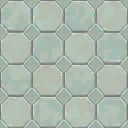 |
 |
The texture used in Mario Kart: Double Dash!! goes by the name YukaRock1, whereas the one used in this game is YukaRock2.
The YukaRock1 texture can be partly seen in the middle of the rotary room with firebars in the Kiosk Demo's touch screen map for this track; the model uses the final YukaRock2 texture, however.
This implies that the YukaRock1 (Double Dash!!'s texture) was used at first.
Model Oddities
| To do: There might be more |
Bowser Castle
There's an unseen very small ramp under the boost panels in Bowser Castle's model, with a black vertex color. It uses the yellow-black stripe texture as in the sides of the grid road (but here the model is untextured to make the ramp shape easier to see).
Considering the material name for the boost panels are kp_jump plus GBA Bowser Castle 2 also has jump ramps textured the same way, it's possible the boost panels in Bowser Castle might've been planned as jump pads at first.
Retro Console Prefix Oddity
Only when the game is in French, in the Send Ghost menu list, the GBA Sky Garden and GCN Yoshi Circuit tracks are named "GBA Jardin Volant GBA" and "GCN Circuit Yoshi GCN" instead of "GBA Jardin Volant" and "GCN Circuit Yoshi". The retro console prefix is erroneously reused as a suffix only in this menu for these two tracks, and in no other language than French. Sky Garden and Yoshi Circuit being the last two tracks listed in the game, this may be an oversight by the game's French translator following an issue encountered with console prefixes during localization.
Early Track Leftovers
N64 Banshee Boardwalk
The track's data contains a course_model.nsbtp (texture pattern) file with the material name hyu_ike1 and texture names hyu_water1 to hyu_water15. However, the model has no such material and textures, and judging by the texture name, the water was probably meant to be in the model rather than as a separate object.
Judging by the fact it has 15 different textures and palettes, this was likely changed to save VRAM.
StaffRoll
| test_circle | StaffRoll(True) |
|---|---|
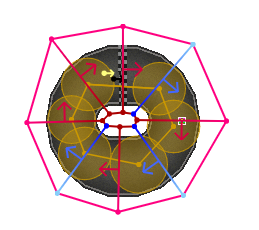 |
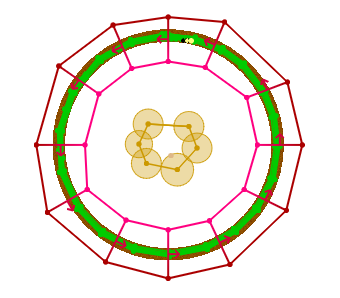 |
Both StaffRoll tracks contain IPOI (item points, shown in light brown) formation from test_circle, which might mean that test_circle was duplicated to both tracks and then edited, as the NKM fog (background) color (132-132-248, light blue) is also the same.
Early Music Leftovers
| To do: Check for more |
SNES Choco Island 2
SSEQ ID: 25 SBNK ID: 72 SWAR ID: 71
The sequence for the whistles (like in the original SNES music), as heard in the Kiosk Demo, is still present in the SSEQ file, but its setting is removed from the SBNK so that it doesn't play.
Coin Mission
SSEQ ID: 44 SBNK ID: 87 SWAR ID: 86
Track 9 uses the instrument ID 12, which is used for the DJ scratches in Figure-8/Mario Circuit and Shroom Ridge themes. The samples for them appear in the corresponding SWAR file too (samples 3 and 4), but the setting isn't present in the SBNK file, so it doesn't play. It's possible that an earlier version of the theme had those DJ scratches playing in the music and they were later removed.
Interestingly, this music doesn't exist in the Kiosk Demo, indicating that this is a leftover from a later prototype.
Unused Sound Effect Sequences
SSAR 0 SSEQ 72
| To do: Check for more, and document those of the Kiosk Demo's SDAT file as well |
In SSARs 0 and 1 (main SFX sequence data), under the sequence data of SSEQ 72 (Shy Guy selection voice), various leftover sequences were found. They all play using SBNK 0 (main SFX sound bank). They aren't assigned to any sequence file in the data. It's unknown if they were used in an earlier build, or if they were some sort of placeholders or just some junk data. Those, especially the item roulette and the menu sounds (see below) happen to be direct conversions of the sequence data from Mario Kart: Double Dash!! as there are no attack/decay/sustain/release rate settings; none of the sound effect sequences in the referred game has them either. Those were added in this game's used counterparts of the unused sequences.
Following is the said data viewed in Nitro Studio 2 (except the comments):
Sequence_72: /* Shy Guy voice, used SEQ */ prg 1 jump Command_190 Command_190: cn4 127, 0 fin /* End of Shy Guy SEQ */ alloctrack 15 /* Unused SFX 1 */ opentrack 1, Command_196 opentrack 2, Command_201 opentrack 3, Command_201 Command_196: prg 6 pan 0 Command_198: volume 127 cn4 127, 0 fin Command_201: prg 7 pan 127 jump Command_198 alloctrack 3 /* Unused SFX 2 */ opentrack 1, Command_217 volume 85 prg 1 Command_208: cn4 99, 9 en4 99, 9 gn4 99, 9 cn5 99, 9 en5 99, 9 gn4 99, 9 cn5 99, 9 en5 99, 9 jump Command_208 Command_217: volume 40 prg 1 wait 12 jump Command_208 alloctrack 3 /* Unused SFX 3 */ opentrack 1, Command_234 volume 100 Command_224: prg 8 bn5 100, 12 bn5 100, 12 bn5 90, 12 bn5 80, 12 bn5 70, 12 bn5 60, 12 bn5 50, 12 bn5 40, 12 fin Command_234: volume 80 wait 5 jump Command_224 alloctrack 3 /* Unused SFX 4 */ opentrack 1, Command_251 volume 120 Command_240: prg 8 bn4 70, 5 an4 80, 5 gn4 90, 6 en4 95, 8 cn4 90, 7 en4 85, 7 gn4 80, 7 an4 75, 7 dn5 70, 7 fin Command_251: volume 85 wait 17 jump Command_240 alloctrack 3 /* Unused SFX 5 */ opentrack 1, Command_264 volume 100 Command_257: prg 0 en4 85, 7 gn4 90, 7 as4 95, 8 cn5 90, 8 en5 95, 8 fin Command_264: volume 65 wait 17 jump Command_257 alloctrack 3 /* Unused SFX 6 */ opentrack 1, Command_277 volume 100 Command_270: prg 0 bn4 99, 7 an4 95, 7 gn4 90, 8 en4 85, 8 ds4 80, 8 fin Command_277: volume 65 wait 17 jump Command_270 alloctrack 3 /* Unused SFX 7 */ porta 57 en5 127, 8 porta_off fin cn4 100, 0 /* Unused SFX 8 */ fin alloctrack 3 /* Unused SFX 9 */ opentrack 1, Command_295 Command_289: prg 0 en4 105, 6 gn4 120, 7 cn5 90, 8 en5 85, 8 fin Command_295: volume 90 wait 16 jump Command_289 prg 12 /* Unused SFX 10 */ cn4 120, 0 fin alloctrack 3 /* Unused SFX 11 */ opentrack 1, Command_308 Command_303: prg 2 cn4 99, 7 en3 90, 7 cn3 80, 8 fin Command_308: volume 90 wait 13 jump Command_303 prg 9 /* Unused SFX 12 */ cn4 60, 20 fin prg 9 /* Unused SFX 13 */ cn4 118, 160 fin
Unused SFX 1
Some sort of step sound followed by a wind ambience.
Unused SFX 2
| Unused | Used |
|---|---|
An earlier item roulette sound. The used sequence is SSEQ 62.
Unused SFX 3
| Unused | Used |
|---|---|
The item getting sound from Mario Kart: Double Dash!!. The used sequence is SSEQ 63.
Unused SFX 4
| Unused | Used |
|---|---|
Earlier SFX for exiting a match, with a different sample. The used sequence is SSEQ 19.
Unused SFX 5
| Unused | Used |
|---|---|
Earlier resume from pause SFX. The used sequence is SSEQ 18.
Unused SFX 6
| Unused | Used |
|---|---|
Earlier pause SFX. The used sequence is SSEQ 17.
Unused SFX 7
Unknown what it would be, through it uses a similar sequence to the kart hopping sound (SSEQ 207).
Unused SFX 8
Another unknown sound, judging by its sequence it's possibly meant to be a kart engine or drifting sound.
Unused SFX 9
| Unused | Used |
|---|---|
Earlier menu selection SFX, similar to that of Kiosk Demo's except the lack of reverb (release event). The used sequence is SSEQ 5.
Unused SFX 10
Uses a sample of the race results display. The used sequences are SSEQ 50 to 57.
Unused SFX 11
| Unused | Used |
|---|---|
Earlier return SFX, sounding similar to that of Kiosk Demo's. The used sequence is SSEQ 14.
Unused SFX 12
| Unused | Used |
|---|---|
The sound for crashing into a wall from Mario Kart: Double Dash!!. The used sequence is SSEQ 129.
Unused SFX 13
Longer version of the sequence above. Oddly this sequence is assigned to the file SET_BRAKE in the Kiosk Demo, but left alone in the final game.
Sound Effect Oddities
SSAR 0 SSEQ 272
Sound effect 272 (SSEQ_272) in SSAR 0 and 1 is supposed to be this bubbly sound, probably when going into the water in beach courses (i.e. Cheep-Cheep Beach), but it doesn't play because of either incorrect SBNK ID (SBNK 18 / Cheep-Cheep Beach sound effects) or the instrument ID (instrument 66). This can be corrected either by changing the SBNK ID to 0 (main SFX), or the instrument number in the sequence to 1.
